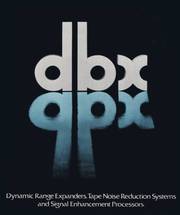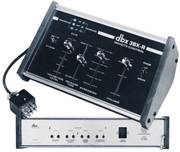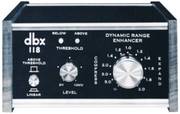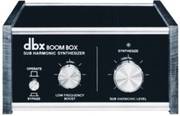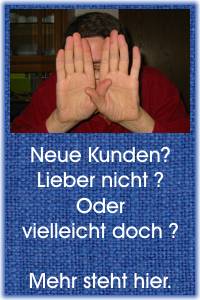Dieser ausführliche dbx Prospekt scheint aus 12/1978 zu sein
Hier sind bereits die Typen dbx 122 MK II enthalten, die gab es 1974 noch nicht. Die einführenden Erklärungen (in Englisch) finden Sie auf der dbx Haupseite. Etwas über die dbx Historie ist im Werden.
3BX - Linear Dynamic Range Expander
dbx has created the state-of-the-art in dynamic range expansion by dividing the audio spectrum into three separate frequency bands. The 3BX incorporates multiple true RMS detectors, and voltage controlled amplifiers. That means the bass, midrange, and treble portions of your music are linearly expanded individually. This achieves stunning results unobtainable from any other expander system.
Powerful, percussive bass notes will not artificially elevate midrange sounds. Midrange crescendos will not cause low level high frequency information to be brought unnaturally into the foreground. For the most complex musical material, it is the only solution when musical integrity must not be compromised.
.
Three rows of yellow and red LED's show how much expansion you're enjoying in each of the three frequency bands - up to 50% overall. The transition level slider sets the point below which the 3BX makes your music quieter and above which it makes your music louder.
.
The 3BX also features source/tape and pre/post switches, in case you wish to use it with a tape recorder. These controls permit you to switch the unit into the system either before or after your tape deck, allowing complete recording and playback flexibility, without touching the cables on the back.
The 3BX is the most sophisticated and satisfying way yet devised to restore the missing dynamic range of recorded music.
3BX SPECIFICATIONS
Expansion ratio: continuously adjustable to 1.5
Dynamic range (peak signal to weighted background noise): 110 dB
Input impedance: 50 K
Input level (nominal): 300 mV
Input level (maximum): 7 v RMS
Output impedance (designed to drive 5 K ohms or greater): 100 ohms
Output level (maximum, 20 Hz to 20 kHz): 7 v RMS
Frequency response: 20Hz to 20 kHz ±.5dB
Input noise (unweighted, referenced to 1 v): -85dBv
Total harmonic distortion: 0.1% typical at 1.0 expansion, 20 Hz to 20 kHz
I.M. distortion (SMPTE): 0.15% typical
Power line requirement (100, 220, 240 optional for export markets): 117 VAC 50 to 60 Hz
Power line consumption: 30 w
Size: 3 3/4" (h) x 17 3/4" (w) x 10 1/4" (d) (mm: 95.25 x 450.85 x 260.35)
Shipping weight: 12 lbs. (5.44 Kg.)
1BX and 2BX - Linear Dynamic Range Expanders
Inspired by the success of the 3BX, dbx set out to make the audible benefits of linear expansion accessible to everyone. With the coming of the 1BX and the 2BX, there is now a dbx expander for every system and budget.
The 1BX is the most sophisticated one-band expander on the market. It provides as much as a 50% improvement in stereo dynamic range over a wide frequency spectrum. Its true RMS detector has an infrasonic filter - 10 dB/octave at 30 Hz - to prevent mistracking caused by vibration, turntable rumble or record warps. Its 10-LED display enables you to monitor the amount and the direction of gain change resulting from the expansion process.
.
The 2BX also provides up to a 50% increase in stereo dynamic range, but with one important difference. It divides the frequency spectrum into two bands, and treats each separately. That's especially important with music of a strongly percussive nature. By separating the lower frequencies, the 2BX doesn't allow the bass or kick drum to influence the vocals or midrange instruments.
The 2BX has two separate 10-LED displays - one for each band. Both the 1BX and the 2BX have a number of important features in common with the 3BX. Their release time is program-dependent, not fixed, resulting in smooth action that does not alter the character of the music as dynamics are expanded and noise is lowered. By reacting appropriately to different kinds of sounds, they preserve the "naturalness" of any given sound. They both are true stereo expanders that maintain rock-solid stereo imaging, unlike some other stereo expanders on the market. And all dbx linear expanders have a pleasant side benefit - up to 20 dB of noise reduction. There isn't a stereo system around that won't be improved by one of this family of dbx expanders.
.
1BX and 2BX - SPECIFICATIONS
Expansion ratio: 1.0 to 1.5 (0 to 50% increase), linear in decibels
Dynamic range (peak signal to weighted background noise): 110 dB
Transition level range: 30 mVto 3 V (threshold)
Attack and release rates: Variable, determined by program loudness and rate of change
Frequency response: ±0.5 dB, 20 Hz to 20 kHz at an expansion ratio of 1.0
Total harmonic distortion: 0.1% typical at 1.0 expansion, 20 Hz to 20 kHz
I.M. distortion (SMPTE): 0.15% typical
Input impedance: High (50 kohms)
Output impedance: Low (the 1 BX is designed to feed tape monitor input or tape deck with long cables)
Maximum output level: 6 volts RMS at 1 kHz
Controls: tape/source switch, pre/post switch, power ON/OFF, transition level, expansion
Indicators: 1BX: power ON L.L.D., gain change (10 L.E.D.'s); 2BX: power ON L.E.D., gain change (10 L.E.D.'s for each of 2 bands)
Connectors (phono jacks): from preamp tape output (x2); to tape recorder auxiliary or line input (x2); from tape recorder output (x2); to preamp tape or monitor input (x2). (1BX also has a quad coupler)
Power requirements: 117 V AC, 50 or 60 Hz
Power consumption: 1BX: 10 watts maximum; 2BX: 20 watts maximum
Dimensions: 1BX: 11" wide (27.8 cm) x 3 3/4" high (9.5 cm) x 10 1/2" deep (25.5 cm); 2BX: 17 3/4" wide (45.1 cm) x 3 3/4" high (9.5 cm) x 10 1/2" deep (25.5 cm)
Weight: 1BX: 4 lbs., 8 oz. (2.0 kg); 2BX: 8 lbs., 5 oz. (3.8 kg)
3BX-R and 3BX Remote Control
The 3BX-R makes the 3BX more convenient, more flexible, and a lot more fun. Of course it allows you to adjust your 3BX from your favorite listening position. But it also gives you more control than ever before.
Besides Expansion and Transition Level controls, which are also found on the 3BX, the 3BX-R includes a Volume control, a Release Time control, a Fade switch, a Bypass switch and an LED display.
Now you can adjust the volume of your system without getting up and walking over to your preamp or receiver. Now you can tailor the reaction time of the 3BX to suit the demands of the music - fast, for uptempo, high energy rock; slow, for quiet symphonic adagios. Fade down or out, to take phone calls or hold conversations, and fade back up without disturbing your original settings. Switch to bypass for instant A-B comparisons, and monitor the 3BX-RS LED display when the front panel LED display of the 3BX is not visible.
Behind a rear cover are four more controls to further refine the operation of the 3BX, including a High Frequency Transition control to allow corrections of high frequency balance problems in the source material. The 3BX-R derives its power from the 3BX and plugs into the 12-pin socket on the rear panel. Simply plug in the 3BX-R, depress the "Remote" switch and you've got a whole new world of sound within your reach.
122 and 124 dbx II - Tape Noise Reduction Systems
The only consumer tape noise reduction system available which allows you to make tape copies that sound exactly the same as the original is the dbx II. It assures that no audible tape noise is added by the tape recording process. Only noise present in the original source will survive the dbx II system.
The 122 is a two-channel system, and the 124 a four-channel system, (both models switchable to record or play). However, the 124, if used for stereo, allows you to simultaneously monitor the noise-reduced signal off tape as you record. You can use both to record live, tape to tape, record to tape, and also for dubbing and taping off radio.
Complex level matching and alignment procedures are unnecessary, since these systems operate linearly, using the dbx patented true rms detectors and voltage controlled amplifiers. This is not the case with competitive systems, such as Dolby® "B". Moreover, Dolby "B" gives you only 7 to 10dB of high frequency noise reduction, vs. an astounding 30dB reduction of tape background noise at all frequencies with the dbx II system. Other features include a bypass switch, power on/off plus a dbx disc playback button. The latter is to be used only to decode commercially available dbx encoded discs, which provide totally noise-free, full dynamic range music reproduction. A playback level control is provided for your convenience.
128 Linear Dynamic Range Enhancer Tape Noise Reduction System
How would you like to make copies of records that sound better than the original ? With reduced noise, and with increased dynamic range? The one machine that can do all that is the dbx 128, which combines the dynamic range enhancement features of the 118 with the tape noise reduction features of the 122.
These two combined modes permit you to expand a recorded program, then dbx II encode the expanded material, so you can easily fit it onto tape. When played in decoded form, you'll hear what you didn't hear on the original - the realism of louder louds and quieter quiets. Moreover, you hear a lot less of something else you heard on the original - annoying surface noise.
For example, suppose you expanded a 40dB dynamic range program by a factor of 1.5, which would result in a dynamic range of 60dB. You could then process it through the dbx II tape noise reduction section of the 128, which would reduce the dynamic range to 30dB. This allows you to place the program on tape above the noise level and below saturation. When decoded, the program would have a dynamic range of 60dB, the same as the expanded original. The tape copy would have 50% more dynamic range than the record, plus the combined benefit of reduced surface noise from the original, due to expansion, with no audible noise added by the tape recording process.
Additional features include power on/off switch, pre/post switches so you can expand material either before or after your tape recorder, in addition to dbx encoded disc playback capability. This provides you with complete front panel flexibility.
118 Linear Dynamic Range Enhancer
The dbx 118 is the most versatile dynamic enhancer available today. It is a single band linear expander, a linear compressor, a limiter and a peak unlimiter. - Yet, its price is modest.
Notice the expansion/compression control. You can use it to set just the amount of dynamic range expansion you want. Where large level variations are undesirable, you can instead compress the entire dynamic range, bringing the quiet and loud portions of your music closer together.
Just to the left is a threshold control. When expanding, this can be used to set the point in your music's dynamic range below which music becomes quieter, and above which it becomes louder. If you place the button on the far left in the out position, the 118 becomes an above-threshold expander, or peak uniimiter. This means only loud portions of the dynamic range which
exceed your pre-set threshold will be expanded, (made louder). Above threshold expansion is most useful for programs which were compressed only at high levels. If your 118 is in compression mode, the reverse is true - it becomes an above threshold compressor or limiter. That means signals rising above your threshold will be made more quiet.
The amber and red LEDs tell you when the signal is above or below threshold. They are your guide in setting threshold levels.
The 118 can be used with Dolby^ "B"tape noise reduction, and will provide additional noise reduction. Two 118's can be coupled to track accurately in four channel applications.
100 Subharmonic Synthesizer
In order to get as much music as possible on a record, recording engineers must limit the depth and excursion of record grooves. So in the recording process, the lower frequencies are often deliberately reduced or cut off altogether.
The dbx 100 recreates this lost portion of the audio spectrum by seizing information in the 50-100 Hz range, creating a signal one octave lower (25-50 Hz) and mixing this new signal back into the program.
By recreating the bottom octave with the dbx 100, you can hear heightened accuracy in the bass, and actually feel the power inherent in a bass note. The "solid-ness" and three-dimensionality of bass heard in a live performance - which can be physically experienced - are restored.
The dbx 100 can be enjoyed with almost any component system. It is easily inserted in the tape monitor circuit of your receiver or amplifier. There are just two controls. One is a Synthesizer control that sets the amount of recreated low frequencies you put into the system. The other is a Low Frequency Boost control specially contoured to produce a smooth blend of the synthesized notes into the music. As you regulate the Low Frequency Boost control, your ears will tell you when it is set "right."
The dbx 100 will intensify your listening experience, no matter what kind of music you listen to. If you like rock or jazz or disco, and you have a higher-powered system, the 100 is capable of creating a new dimension, where the physicality of the music will engulf you. If you like classical music, try listening to Tchaikovsky's 1812 Overture or Beethoven's Sixth Symphony with the 100. The attack of the tympani and the richness of massed double-basses produce a sensation unlike anything you have ever experienced from recorded music.
Your local dbx dealer will be happy to demonstrate the 100 for you. But be prepared for an experience that goes beyond listening.

